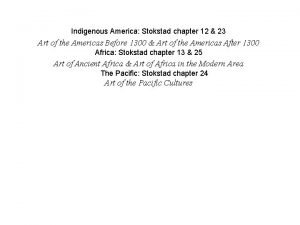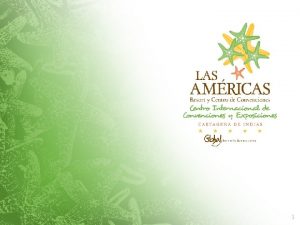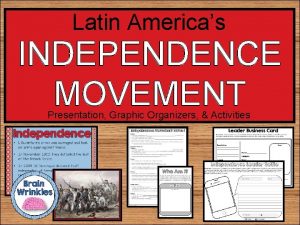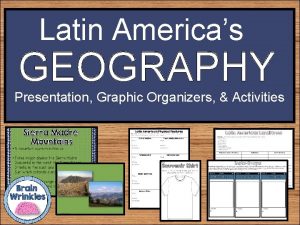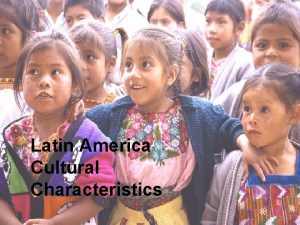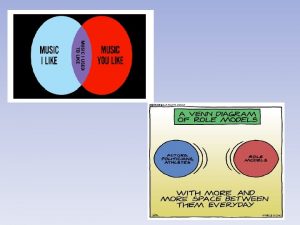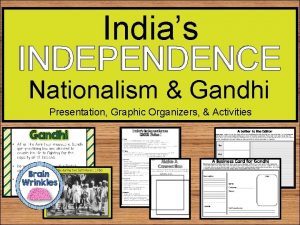Latin Americas CULTURAL CHARACTERISTICS Presentation Graphic Organizers Activities







































- Slides: 39

Latin America’s CULTURAL CHARACTERISTICS Presentation, Graphic Organizers, & Activities

STANDARDS: SS 6 G 4 The student will describe the cultural characteristics of people who live in Latin America and the Caribbean. a. Describe the results of blending of ethnic groups in Latin America and the Caribbean. b. Explain why Latin America is a region based on the languages of Portuguese and Spanish. c. Evaluate how the literacy rate affects the standard of living. © Brain Wrinkles

LA’s Culture CLOZE Notes 1 Diversity • The cultures of Latin America are diverse; the customs, languages, and religions from an area are a _______________________. • The people and cultures of Latin America are a _______________________ in the area and the influences of the countries that created colonies there. • Europeans, Africans, and Native Americans ______________ and developed unique cultures over time. Indigenas • The native peoples of the Americas are the descendants of the _______________________ of North and South America. • Pueblos indigenas ______________ is a common term in Spanishspeaking countries. • People with Native American ancestry make up the majority of the population in _______________________. Mestizos • After ______________ moved into Latin America, ethnic groups began to change. • Many Spanish people _______________________ of the area. • Their offspring were called _________ , or people of mixed European and Indian ancestry. • Mestizos are the largest ethnic group in _______ , Venezuela, and many countries in northern Latin America. Africans • Europeans brought Africans to the New World and forced them to _______________________. • ______________ of these people live in Latin America today. • Many live in Brazil, Panama, and the ______________. Mulattoes • When Africans married Europeans, their offspring were known as ______________ , or people of mixed African and European descent. • Brazil, Panama, ________ , Haiti, the Dominican Republic, and Colombia have the highest populations of mulattoes. Problems • While Latin Americans are _______________________ , there are still some problems. • People with European ancestry have ______________ , education, and healthcare. • Indigenas, mestizos, and mulattoes have begun to ______________ in their countries. © Brain Wrinkles

LA’s Culture CLOZE Notes 2 New Empires • After ______________ discovered the New World in 1492, Spain, Portugal, and other European countries sent ships to explore these new lands. • Spain conquered and settled in Florida, Mexico, large parts of ______________ , and many islands in the Caribbean. • Because most of the countries in Latin America were ______________ , the Spanish language is the most spoken language of the region. • Since Portugal claimed Brazil, Brazilians speak the ______________. Languages • The term Latin America was coined in the 1800 s to group the countries that spoke mostly ______________ (Spanish and Portuguese). • In addition to the two primary languages of ______________ , the shared history, culture, and religion have made the term Latin America one that unites Mexico, Central and South American, and the Caribbean. • Nearly all people in Latin America ______________ with a few exceptions. • In ______________ , the primary language is Portuguese. • The people in Haiti and French Guiana speak ______________. Religion • The major religion in the area is ______________ , which was brought by European settlers. • ______________ of the people in the area are Roman Catholic. • Today, many of the religious customs in the region reflect a blend of ancient native and ______________. • An example is the ______________ in Mexico, which blends Native American beliefs about the afterlife with Christian beliefs. © Brain Wrinkles

LA’s Culture CLOZE Notes 3 Literacy • Literacy rate is the percentage of a country’s population over the age of 15 that can ______________. • Traditionally, nations with higher literacy rates tend to have an ______________ economically. • Literacy is a major factor in whether a person is able to be ______________. • Having a high literacy rate is important to the ______________ in a country. • People who can read get better jobs, earn more money, and can afford to ______________. • They can afford housing, food, healthcare, & ______________. Latin America • The countries of Latin America have ______________ of their people in the past decade. • On average, almost ______________ in Latin America can read and write; unfortunately, that leaves 11% who are illiterate. • Today, Latin American countries with low literacy rates are eager to improve literacy and ______________ for citizens. Standard of Living • The standard of living ______________ of the people in the country) is often higher in countries where the literacy rate is high. Cycle of Poverty • One reason that many people cannot read/write is that their communities ______________ to pay for teachers or schools. • A ______________ can develop when people cannot get an education… • Uneducated are forced to get ______________ , so they cannot get enough money to pay for their children’s education, and cycle continues for generations. • The standard of living remains low for these families because their ______________. Time to Help • The goal of every country is to have ______________ among its people. • Many governments, missionaries, & aid groups come to the poorest countries in Latin America & are ______________ in educating their children. © Brain Wrinkles

Latin America’s Cultural Characteristics Ethnic Groups, Languages, & Literacy Rate © Brain Wrinkles

Ethnic Groups © Brain Wrinkles

Diversity • The cultures of Latin America are diverse; the customs, languages, and religions from an area are a result of its history. • The people and cultures of Latin America are a blend of the native groups in the area and the influences of the countries that created colonies there. • Europeans, Africans, and Native Americans have intermarried and developed unique cultures over time. © Brain Wrinkles

Indigenas • The native peoples of the Americas are the descendants of the pre-Columbian inhabitants of North and South America. • Pueblos indigenas (indigenous peoples) is a common term in Spanish-speaking countries. • People with Native American ancestry make up the majority of the population in Bolivia, Peru, and Guatemala. © Brain Wrinkles

© Brain Wrinkles

Mestizo Indigenas © Brain Wrinkles

Mestizos • After Spanish settlers moved into Latin America, ethnic groups began to change. • Many Spanish people married indigenous people of the area. • Their offspring were called mestizos, or people of mixed European and Indian ancestry. • Mestizos are the largest ethnic group in Mexico, Venezuela, and many countries in northern Latin America. © Brain Wrinkles

© Brain Wrinkles

© Brain Wrinkles

Africans • Europeans brought Africans to the New World and forced them to work as slaves. • Descendants of these people live in Latin America today. • Many live in Brazil, Panama, and the West Indies. © Brain Wrinkles

© Brain Wrinkles

© Brain Wrinkles

Mulattoes • When Africans married Europeans, their offspring were known as mulattoes, or people of mixed African and European descent. • Brazil, Panama, Cuba, Haiti, the Dominican Republic, and Colombia have the highest populations of mulattoes. © Brain Wrinkles

© Brain Wrinkles

Problems • While Latin Americans are proud of their heritage, there are still some problems. • People with European ancestry have better jobs, education, and healthcare. • Indigenas, mestizos, and mulattoes have begun to demand equality in their countries. © Brain Wrinkles

Language & Religion © Brain Wrinkles

New Empires • After Christopher Columbus discovered the New World in 1492, Spain, Portugal, and other European countries sent ships to explore these new lands. • Spain conquered and settled in Florida, Mexico, large parts of Central and South America, and many islands in the Caribbean. • Because most of the countries in Latin America were conquered by Spain, the Spanish language is the most spoken language of the region. • Since Portugal claimed Brazil, Brazilians speak the Portuguese language. © Brain Wrinkles

© Brain Wrinkles

Languages • The term Latin America was coined in the 1800 s to group the countries that spoke mostly Romance languages (Spanish and Portuguese). • In addition to the two primary languages of Spanish and Portuguese, the shared history, culture, and religion have made the term Latin America one that unites Mexico, Central and South American, and the Caribbean. © Brain Wrinkles

• Spanish -- GREEN • Portuguese -- ORANGE • French -- BLUE © Brain Wrinkles

Languages • Nearly all people in Latin America speak Spanish with a few exceptions. • In Brazil, the primary language is Portuguese. • The people in Haiti and French Guiana speak French. © Brain Wrinkles

Religion • The major religion in the area is Catholicism, which was brought by European settlers. • Over 90% of the people in the area are Roman Catholic. • Today, many of the religious customs in the region reflect a blend of ancient native and European traditions. • An example is the “Day of the Dead” in Mexico, which blends Native American beliefs about the afterlife with Christian beliefs. © Brain Wrinkles

© Brain Wrinkles

© Brain Wrinkles

Literacy Rate © Brain Wrinkles

Literacy • Literacy rate is the percentage of a country’s population over the age of 15 that can read and write. • Traditionally, nations with higher literacy rates tend to have an easier time developing economically. • Literacy is a major factor in whether a person is able to be successful in the workplace. © Brain Wrinkles

© Brain Wrinkles

Literacy • Having a high literacy rate is important to the success of the people in a country. • People who can read get better jobs, earn more money, and can afford to buy better things. • They can afford housing, food, healthcare, & clothing for their families. © Brain Wrinkles

Latin America • The countries of Latin America have improved the literacy rates of their people in the past decade. • On average, almost 90% of adults in Latin America can read and write; unfortunately, that leaves 11% who are illiterate. • Today, Latin American countries with low literacy rates are eager to improve literacy and raise the standard of living for citizens. © Brain Wrinkles

Literacy Rates in Latin America © Brain Wrinkles

Standard of Living • The standard of living (economic level of the people in the country) is often higher in countries where the literacy rate is high. High Literacy Rate © Brain Wrinkles = High Standard of Living

Cycle of Poverty • One reason that many people cannot read/write is that their communities cannot afford to pay for teachers or schools. • A cycle of poverty can develop when people cannot get an education… • Uneducated are forced to get low-paying jobs, so they cannot get enough money to pay for their children’s education, and cycle continues for generations. • The standard of living remains low for these families because their education level is low. © Brain Wrinkles

Time to Help • The goal of every country is to have 100% literacy rates among its people. • Many governments, missionaries, & aid groups come to the poorest countries in Latin America & are assisting the people in educating their children. © Brain Wrinkles

Literacy Rates in Latin America © Brain Wrinkles
 Science staar supplemental aids
Science staar supplemental aids Blank graphic organizers for math staar
Blank graphic organizers for math staar Supplemental aids
Supplemental aids Graphic organizers for algebra
Graphic organizers for algebra Mcas accommodations codes
Mcas accommodations codes Time sequence pattern organizer examples
Time sequence pattern organizer examples Pictorial models of geometric figures
Pictorial models of geometric figures Marzanos strategies
Marzanos strategies Mcas accommodations
Mcas accommodations Graphic weight examples
Graphic weight examples Ghost graphic story graphic and wayfinding
Ghost graphic story graphic and wayfinding Advance organizers examples
Advance organizers examples Advance organizer
Advance organizer Expository advance organizers examples
Expository advance organizers examples Dear organizers
Dear organizers Register and signaling vocabulary
Register and signaling vocabulary Marzano's 9 high yield strategies
Marzano's 9 high yield strategies Cues questions and advance organizers
Cues questions and advance organizers Cues questions and advance organizers
Cues questions and advance organizers The statement of cash flows helps users
The statement of cash flows helps users Indoor and outdoor sport
Indoor and outdoor sport Primary and support activities
Primary and support activities Examples of primary activities
Examples of primary activities Spanish caste system in the americas
Spanish caste system in the americas Spanish colonization of the americas
Spanish colonization of the americas Soroptimist international of the americas
Soroptimist international of the americas Art of the americas before 1300
Art of the americas before 1300 Ib history of the americas study guide
Ib history of the americas study guide When did britain colonize america
When did britain colonize america Declaración sobre seguridad en las américas 2003
Declaración sobre seguridad en las américas 2003 Spanish caste system in the americas
Spanish caste system in the americas Americas guardians mc
Americas guardians mc Centro internacional de convenciones
Centro internacional de convenciones The beginnings of our global age europe and the americas
The beginnings of our global age europe and the americas Transversal de las americas
Transversal de las americas Openedge multi-tenant database
Openedge multi-tenant database Chapter 24 new worlds the americas and oceania
Chapter 24 new worlds the americas and oceania Chapter 24 new worlds the americas and oceania
Chapter 24 new worlds the americas and oceania Chapter 24 the americas and oceania
Chapter 24 the americas and oceania Chapter 20 worlds apart the americas and oceania
Chapter 20 worlds apart the americas and oceania


























